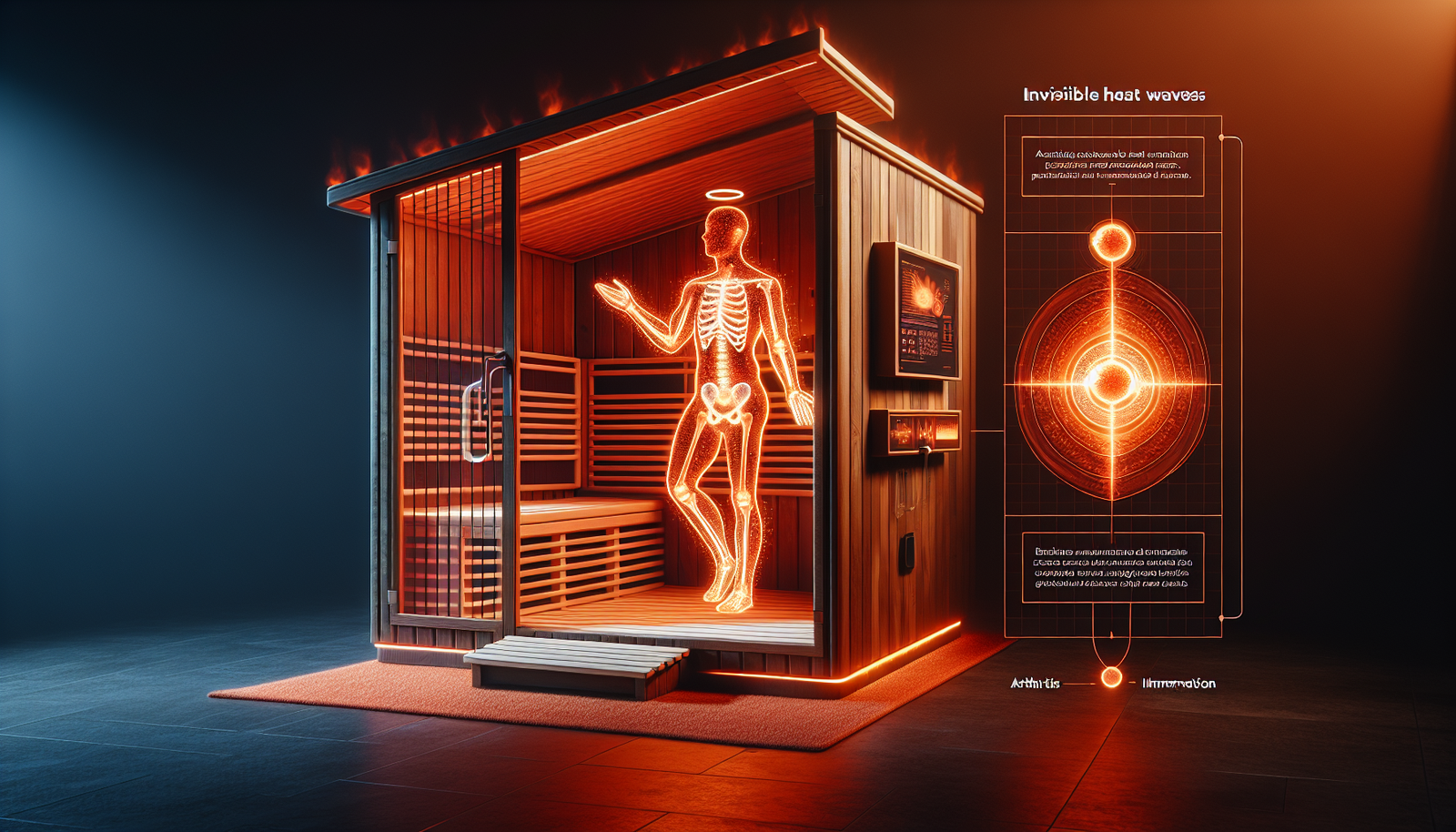Hey, have you ever wondered if infrared saunas are helpful for arthritis? Well, you’re in the right place! In this article, we’ll explore the potential benefits of using infrared saunas as a natural remedy for arthritis. So, grab a cozy blanket and get ready to discover what these saunas can do for you!

What is arthritis?
Arthritis is a common condition that affects millions of people worldwide. It is characterized by inflammation and pain in one or more joints. There are many different types of arthritis, including osteoarthritis, rheumatoid arthritis, and psoriatic arthritis. The symptoms of arthritis can vary from person to person, but they often include joint pain, stiffness, swelling, and limited range of motion. Arthritis can significantly impact a person’s quality of life, making it important to explore various treatment options to manage symptoms and improve overall well-being.
Benefits of infrared saunas
In recent years, infrared saunas have gained popularity as a potential therapy for arthritis. These saunas use infrared light to generate heat, providing numerous benefits for individuals with arthritis. Let’s delve into some of the benefits that infrared saunas offer.
Pain relief
One of the key advantages of using an infrared sauna for arthritis is the potential for pain relief. The heat generated by the sauna can penetrate deep into the joints and muscles, helping to alleviate pain and discomfort. Many individuals with arthritis have reported experiencing significant pain relief after regular sessions in an infrared sauna. By targeting the source of the pain, the heat from the sauna can provide a soothing and therapeutic effect, allowing individuals to experience temporary relief from their symptoms.
Improved circulation
Arthritis can cause poor circulation, leading to reduced blood flow to the affected joints. Infrared saunas can help enhance circulation by causing blood vessels to dilate, allowing for increased blood flow to the joints and muscles. Improved circulation can aid in delivering oxygen and essential nutrients to the affected areas, promoting healing and reducing inflammation. Additionally, better blood flow can flush out toxins and metabolic waste products from the joints, further contributing to pain relief and improved joint health.
Reduced inflammation
Inflammation is a hallmark of arthritis and is responsible for much of the pain and swelling experienced by individuals with the condition. Infrared saunas have been found to have anti-inflammatory effects, with studies showing a decrease in inflammatory markers after sauna sessions. The heat from the sauna can help reduce inflammation by stimulating the production of heat shock proteins and promoting the release of endorphins, which are natural pain-relieving and anti-inflammatory chemicals in the body. By reducing inflammation, infrared saunas can provide relief from arthritis symptoms and improve overall joint function.
Relaxation and stress reduction
Living with arthritis can be incredibly stressful, as the constant pain and discomfort can take a toll on both the physical and mental well-being. Infrared saunas offer a relaxing and soothing environment that can help alleviate stress and promote relaxation. The warm and tranquil atmosphere of the sauna can induce a state of calmness and tranquility, allowing individuals to unwind and escape from the pressures of daily life. This relaxation not only provides psychological benefits but can also help loosen tight muscles and relieve muscle tension, further contributing to pain relief and improved mobility.
Understanding infrared saunas
Before considering the use of an infrared sauna for arthritis, it is essential to understand how they work, the different types available, and the necessary safety precautions.
How do infrared saunas work?
Infrared saunas use infrared lamps or panels to emit invisible light that penetrates the skin and generates heat. Unlike traditional saunas, which heat the air around you, infrared saunas directly heat your body. The heat from the infrared light is absorbed by the skin, muscles, and joints, causing an increase in body temperature. This heat stimulates sweat production, promoting detoxification and offering the many benefits associated with using infrared saunas.
Types of infrared saunas
There are several types of infrared saunas available, including far-infrared (FIR), near-infrared (NIR), and full-spectrum infrared saunas. Far-infrared saunas emit longer wavelengths of infrared light, which can penetrate deeper into the body, providing more profound therapeutic benefits. Near-infrared saunas emit shorter wavelengths, which are absorbed more superficially and can be beneficial for the skin. Full-spectrum infrared saunas combine both far-infrared and near-infrared wavelengths, offering a wider range of benefits. You can choose the type of sauna that best suits your needs and preferences, keeping in mind the specific benefits you are seeking for your arthritis symptoms.
Safety precautions
While infrared saunas are generally safe, it is important to take certain precautions, especially if you have arthritis or any underlying health conditions. Before using an infrared sauna, consult with your healthcare provider to ensure that it is a suitable therapy for you. They can advise you on any potential risks and provide personalized recommendations based on your specific circumstances. Additionally, it is vital to stay hydrated during sauna sessions to prevent dehydration. Start with shorter sessions and gradually increase the duration and temperature as your body acclimates to the heat. It is also essential to listen to your body and monitor how you feel during and after sauna sessions. If you experience any adverse reactions or worsening of symptoms, discontinue sauna use and seek medical attention.
Arthritis symptoms
Before exploring the potential benefits of infrared saunas for arthritis, it is crucial to understand the symptoms commonly associated with the condition. Arthritis symptoms can vary depending on the type and severity of the condition. Here are some of the most common symptoms experienced by individuals with arthritis:
Joint pain
Joint pain is a primary symptom of arthritis. It can range from mild to severe and may be constant or intermittent. Joint pain can interfere with daily activities and significantly impact mobility and quality of life.
Stiffness
Stiffness is another prevalent symptom of arthritis. It is often most pronounced in the morning or after periods of inactivity. Stiff joints can make it difficult to move or perform tasks that require flexibility.
Swelling
Inflammation in the joints can lead to swelling, which is a common symptom in many types of arthritis. Swollen joints may feel tender to the touch and can be accompanied by redness and warmth.
Limited range of motion
As arthritis progresses, it can cause a decrease in the range of motion. This can make it challenging to perform simple movements or engage in activities that require joint flexibility.

Research on infrared saunas and arthritis
While anecdotal evidence and user testimonials suggest that infrared saunas can provide relief for arthritis symptoms, it is essential to examine the existing research and scientific evidence surrounding this therapy.
Studies supporting the use of infrared saunas for arthritis
Several studies have investigated the efficacy of infrared saunas for arthritis. A 2017 study published in the Journal of Clinical Rheumatology found that infrared sauna sessions led to improvements in pain, stiffness, and fatigue among individuals with rheumatoid arthritis. Another study published in the journal Rheumatology International in 2019 demonstrated that infrared sauna therapy reduced pain and improved physical functioning in individuals with osteoarthritis. These studies suggest that infrared saunas may be a beneficial therapy for managing arthritis symptoms, although further research is needed to confirm these findings.
Clinical trials and their findings
In addition to observational studies, some clinical trials have been conducted to evaluate the effectiveness of infrared saunas for arthritis. A randomized controlled trial published in the journal Complementary Therapies in Medicine in 2018 examined the effects of infrared sauna therapy on individuals with rheumatoid arthritis. The study found that sauna therapy significantly reduced pain and improved quality of life compared to a control group. Another randomized controlled trial published in the journal Clinical Rheumatology in 2020 assessed the effects of infrared sauna use in individuals with fibromyalgia, a condition often associated with arthritis. The trial showed that regular sauna sessions improved pain and sleep quality in the participants. These clinical trials provide promising evidence for the potential benefits of infrared saunas in managing arthritis symptoms.
Alternative therapies and their effectiveness
While infrared saunas show promise as a complementary therapy for arthritis, there are many other alternative therapies that individuals with arthritis may consider. These include acupuncture, massage therapy, hydrotherapy, and low-impact exercise. Each therapy has its own benefits and considerations, and it is important to consult with a healthcare provider to determine the most suitable treatment plan for your specific needs.
Considerations for using infrared saunas for arthritis
When considering the use of an infrared sauna for arthritis, it is essential to take an individualized approach and consider certain factors that may affect its effectiveness.
Individualized approach
Arthritis is a complex condition, and its impact can vary widely from person to person. It is crucial to understand that what works for one individual may not work for another. It may take some trial and error to determine whether infrared sauna therapy is effective for your particular case of arthritis. Pay attention to how your body responds to the sauna sessions and adjust the frequency and duration accordingly.
Consultation with healthcare provider
Before incorporating infrared saunas into your arthritis management plan, consult with your healthcare provider. They can provide valuable guidance and ensure that this therapy is safe and suitable for your specific condition. A healthcare professional will be able to evaluate your medical history, assess any potential risks, and make recommendations based on your individual needs.
Frequency and duration of sauna sessions
The frequency and duration of sauna sessions may vary depending on your condition and tolerance. Start with shorter sessions, typically around 10-15 minutes, and gradually increase the duration as your body becomes accustomed to the heat. It is important to listen to your body and avoid overexertion. Aim for regular sauna sessions, with at least two to three sessions per week to experience the potential benefits. However, everyone’s needs are unique, so be sure to adjust the frequency and duration of sessions based on your comfort level and response to the therapy.
Potential risks and contraindications
While infrared saunas are generally considered safe, certain risks and contraindications should be taken into account, especially if you have arthritis or any underlying health conditions.
Dehydration
Infrared saunas generate heat, causing increased sweating, which can lead to dehydration if adequate fluid intake is not maintained. It is essential to hydrate before, during, and after sauna sessions to prevent dehydration. Ensure you drink enough water or electrolyte-rich fluids to replenish lost fluids and maintain proper hydration.
Heat sensitivity
Some individuals with arthritis may be sensitive to heat or have conditions that make them more prone to heat-related issues. It is important to listen to your body and be aware of any discomfort or adverse reactions during sauna sessions. If you experience dizziness, lightheadedness, or any symptoms of overheating, it is crucial to exit the sauna and seek medical attention if necessary.
Skin conditions
Individuals with certain skin conditions, such as eczema or psoriasis, may need to exercise caution when using infrared saunas. The heat and sweat generated by the sauna can potentially exacerbate these conditions. If you have any preexisting skin conditions, consult with a dermatologist or healthcare provider to determine if infrared sauna therapy is suitable for you.
Cardiovascular conditions
Individuals with cardiovascular conditions should approach infrared sauna therapy with caution. The heat from the sauna can raise heart rate and blood pressure, which can be problematic for those with certain heart conditions. If you have any cardiovascular conditions, discuss the potential risks with a healthcare provider before using an infrared sauna.
Pregnancy
Pregnant individuals should avoid using infrared saunas, as the heat can raise body temperature, potentially harming the fetus. If you are pregnant or trying to conceive, it is best to avoid infrared sauna therapy until after the pregnancy.
Tips for using infrared saunas for arthritis
To ensure a safe and effective experience when using infrared saunas for arthritis, consider the following tips:
Hydration
As mentioned earlier, staying hydrated is crucial when using an infrared sauna. Drink plenty of fluids before, during, and after each session to maintain optimal hydration levels and prevent dehydration.
Gradual exposure to heat
If you are new to using infrared saunas, start with shorter sessions and lower temperatures. Allow your body to acclimate to the heat gradually. Over time, you can increase the duration and temperature as your tolerance improves.
Monitoring symptoms
Pay attention to how your body responds to the sauna sessions. Monitor changes in pain levels, joint mobility, and overall well-being. You may find it helpful to keep a journal or record your experiences to track your progress over time.
Post-sauna care
After each sauna session, take the time to cool down and rest. Relaxation and recovery are essential for allowing your body to maximize the benefits of the sauna. Ensure you replenish any lost fluids by drinking water or electrolyte-rich beverages. Additionally, consider stretching or performing gentle exercises to help maintain joint mobility and flexibility.
User experiences and testimonials
While scientific research provides valuable insights into the potential benefits of infrared saunas for arthritis, it is also helpful to consider the experiences and testimonials of individuals who have tried this therapy. Many people with arthritis have reported significant improvements in pain levels, joint mobility, and overall well-being after incorporating regular infrared sauna sessions into their treatment plans. However, it is important to remember that individual experiences may vary, and what works for one person may not work for another. It is always advisable to consult with a healthcare provider and approach infrared sauna therapy as part of a comprehensive arthritis management plan.
Conclusion
Infrared saunas show promise as a complementary therapy for individuals living with arthritis. The heat generated by these saunas can provide pain relief, improve circulation, reduce inflammation, and promote relaxation and stress reduction. Scientific research supports the potential benefits of infrared saunas for arthritis, with studies and clinical trials showing positive outcomes in terms of pain reduction and improved quality of life. However, it is important to take an individualized approach, consult with a healthcare provider, and consider any potential risks or contraindications before incorporating infrared sauna therapy into your arthritis management plan. By following the necessary precautions and understanding your body’s response to the therapy, you can potentially experience the benefits of infrared saunas and find relief from arthritis symptoms. Further research is still needed to establish the long-term effectiveness and optimal usage of infrared saunas for arthritis, but the current evidence is promising, paving the way for future research directions in this field.

